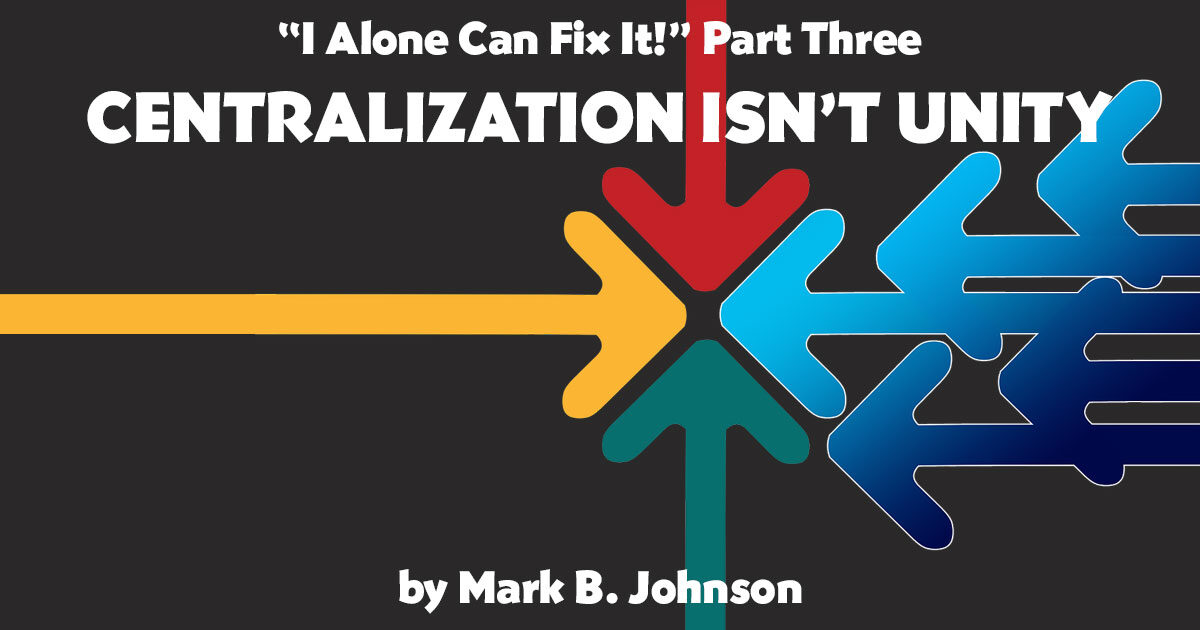“I Alone Can Fix It,” Part 3: Centralization Isn’t Unity
by Mark Johnson | 25 June 2025 |
(Read part 1 of this series here.)
(Read part 2 of this series here.)
I wrote before about how the accreditation of Loma Linda propagated accreditation and higher education down the line, to our colleges, and eventually even to our seminaries. It was the theologians that struggled most with this, however. Even when they ventured out for further training, their education was often based on a fundamentalistic, faith-based approach to the discovery of truth.
Meanwhile, a new, well-educated, affluent, independent, intellectual layer, whose education was based not on faith, but on the scientific method of discovering truth, was being formed in the church. This group included physicians, dentists, nurses, lawyers, engineers, accountants, and numerous other professionals. The original objective and desired influence of this group of professionals was, as far as I can determine, unique when compared to other churches. Those in healthcare were viewed by Ellen G. White as being ministers in their own right. They were to be equal with ministers of the Word in the general ministry of the church. They were the right arm of the ecclesiastic body.
Structurally, they and the other professionals form a bridge between the traditional layers of religious leaders and the common laity. I believe this was ordained by God. While many religious organizational structures have a highly hierarchical structure, with the leaders almost tyrannizing the laity, Christ said His church was to be different. His church was to demonstrate true servant leadership (Matthew 20:25-28). Leadership was to come from many areas. As the spirit and the body are one, the church was to exemplify a oneness that utilized to the fullest the skills, education, and expertise of all members equally (Acts 6:1-7; 1 Corinthians 12:4-31; Ephesians 4:1-13). The president of the General Conference, while being held to a different level of accountability, was not to be seen as being more important or of more value to the church body than the local pastor or kindergarten teacher.
Wholism, the church as a complete body utilizing all its parts, was to inform the basic structure of the organization. We did not establish a large and expensive educational system just to indoctrinate our children. Nor was it only to produce an affluent “middle tier” that can support the church with their tithes and offerings. They were not simply to play the role of “expensive flypaper,” attracting interested patients and clients to hand off to the ministers to “hit” with the gospel. They were to share in the leadership and ministry of the organization as appropriate. All members were to be creative thinkers, not mere reflectors of the thoughts of others. The organizational structure was to be horizontal. It was not intended to be a centralized vertical one, such as the “Gentiles” love.
The goal we haven’t met
Here’s where things get really touchy.
In his findings of fact and conclusions of law and judgment order in the 1986 case of Proctor v. General Conference of Seventh-day Adventists, District Judge William T. Hart determined that “Next to the Roman Catholic Church, the Adventist Church is the most centralized of all major Christian denominations in this country.”
There is nothing sacred about the organizational makeup of the Adventist church. The structure is not heavenly ordained. The General Conference in session, even when represented from around the world, is not necessarily the voice of God. The president of the General Conference may be a selfish and opinionated man. General Conference committees may have entrenched themselves behind the “sacredness of power” in the organization.
If these comments are heretical, then Ellen White was a heretic.
There are great advantages and potential dangers in having a dead prophet. While alive, their messages can directly express disappointment and displeasure with individuals, committees, plans, and economic expenditures. They can also emphatically correct gross misinterpretations of their messages. Once dead, however, subtle, or even direct, messages may be twisted at will into misinformation and disinformation.
Our prophet warned numerous times about the dangers of one man, or a few men, taking over the leadership of the church.
“The error that some are in danger of committing is in giving to the mind and judgment of one man, or of a small group of men, the full measure of authority and influence that God has vested in His church, in the judgment and voice of the General Conference assembled to plan for the prosperity and advancement of His work.” Testimonies, vol. 9, pp. 260, 261
But what if a large assembly of men, mainly through fear or hope of gain, relinquish their thought, voice, and vote to supporting the ideas of one man, or a small group of men?
It has been my honor and pleasure to serve on a number of both church and public boards and committees in my life. I have found a stark difference between these two categories of groups. The church-related ones are often brought together to vote in harmonious agreement on decisions that have already been made in back rooms by smaller groups in private. Unanimous votes are seen as being evidence that the Spirit is leading.
In my public life, deliberation and questioning in the pursuit of differing opinions and new ideas is more the rule. Heated debate and close votes are not necessarily seen as being divisive. Representatives of constituencies do their best to reflect the thoughts and desires of those represented. Those who vote against the majority, however, are expected to fully support the board’s decision in public or resign quietly from the board if they do not feel they can live with the result.
The idea of the supreme authority of the Adventist church “residing in its members who participate in a representative model of governance,” wrote Stanley Patterson in a 2019 paper, is an illusion. Representative votes take place only at the local level for local conference officers. After that, representatives with the privilege of voting for church officers have all been appointed, frequently by the very ones who then stand for office. This circular selection of leadership is almost the definition of a conflict of interest. The determination of church leadership is ultimately achieved by only those who owe their current, and potentially their future, employment to the ones they elect.
Centralization isn’t unity
While it is easy to get angry at this situation, there is plenty of blame to be shared for the strongly centralized church structure under which we currently find ourselves. I do not, for the most part, blame current church leaders for the system. In large part I blame myself and my fellow colleagues in the well-educated, affluent, independent, intellectual layer of the church. We have abdicated our leadership role in the church. Because of this abdication, our leaders have often been required to take on more obligations of leadership than they have desired to ensure survival of the organization. But we are clearly not living up to the aspirations of wholistic church unity that Paul outlined in his epistle to the Ephesians. And, I believe, it has gotten worse over time.
My greatest frustration is in trying to find ways to reverse this trend. Whether or not church leadership is responsible for the current status quo, there seems to be little motivation for reform. Wealthy conservatives who are pleased with the current situation ensure its persistence through the influence of large donations. Frustrated progressives mistakenly seem to think they can force change by withholding their tithes and offerings, or by donating to dissident offshoots.
The conservatives are winning on this front.
It is time for those of us who feel we might be intelligent, intellectual, creative, and innovative thinkers to find a way through the bureaucratic filters we have allowed to form in the development of our current centralized church structure. While many of the best and brightest denominational employees have left the formal organization to work in healthcare, I believe there are still some within the system who are yearning for support and leadership from without. We must find them and help them.
I alone, because I am a layman, can fix it. But I can’t fix it alone. It will take all of us.
 Mark B. Johnson is a graduate of Pacific Union College and Loma Linda University, with a medical residency at Johns Hopkins University in Preventive Medicine and Public Health. He is a retired local public health officer from the Denver metropolitan region. He’s an adult Sabbath School class teacher and church board vice-chair at the Boulder Adventist church.
Mark B. Johnson is a graduate of Pacific Union College and Loma Linda University, with a medical residency at Johns Hopkins University in Preventive Medicine and Public Health. He is a retired local public health officer from the Denver metropolitan region. He’s an adult Sabbath School class teacher and church board vice-chair at the Boulder Adventist church.




